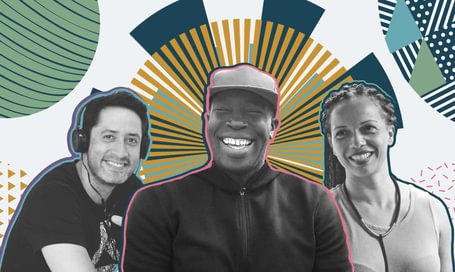Documentary Interview Techniques That Actually Work

Creating a compelling documentary-style video requires more than just fancy equipment and skilled editing.
We know…
It sounds so easy, but there is something VERY important that can make or break your project.
We are talking about the interview process.
Conducting an engaging and informative interview is an art that every filmmaker should master.
In this guide, we'll walk you through the steps of interviewing a person for a documentary-style video, making the experience both fun and educational.
Step 1: Know Your Goal
Whether you’re making a documentary or filming an interview for a corporate project, the starting point is a clear vision.
Start with a simple statement about the goal of your project.
Draft an outline of your story. Think of the picture from your grade school class of the sandwich as a metaphor for an essay. A clear open (the bread) three core points (the filling) and the end (the other slice of bread).
Think through the overall tone and style. Your approach to the interview will change based on your creative direction.
Step 2: Research and Preparation
Before diving into the interview, it's essential to conduct thorough research about your subject.
Learn about their background, experiences, and expertise.
Understanding their story will not only help you formulate thoughtful questions but also establish a connection with your interviewee.
Prepare a list of questions that cover various aspects of their life or expertise, ensuring your conversation remains engaging and informative.
If possible, schedule a brief pre-interview to introduce yourself, learn about the subject, and get a better sense of who they are.
If you need a talent waiver, be sure to address any legal requirements upfront.
Step 3: Establish a Connection
Building a relationship with your interviewee is crucial for a successful interview. A relaxed and open interviewee is more likely to share valuable information and appear believable.
This starts before they sit in a chair and the cameras turn on. Talk to them about the day and make them feel comfortable.
Explain the “rules” of the interview. Let them know that if they mess up or don’t love an answer they can always resay it.
If possible, offer light hair and makeup or give them time to freshen up before the interview.
Start the conversation casually to ease any nerves and establish a comfortable atmosphere.
Show genuine interest in their story and let them know you value their insights.
Step 4: Ask Open-Ended Questions
Craft questions that encourage detailed responses. Open-ended questions prompt interviewees to elaborate on their experiences, emotions, and thoughts, leading to richer content for your video.
Instead of asking yes-or-no questions, opt for inquiries that begin with words like "how," "why," or "tell me about."
For example, ask, "How did you feel when you experienced that moment?" or "Tell me about your journey in this field."
In other words, make it easy for them to elaborate.
You can also keep the questions simple and have a conversation. Sharing your thoughts along the way so it doesn’t just feel like an awkward game of 21 questions.
The words you choose and your style will influence how they perform and what they say. They might mimic your style, so be aware of yourself in the process.
Step 5: Active Listening and Follow-Up Questions
During the interview, listen. Show genuine curiosity, and when appropriate, ask follow-up questions based on their answers. This demonstrates that you are genuinely interested in their story and encourages them to share more.
Here’s a pro-tip: Have someone else on your team listening to ensure you get what you need and everything sounds correct. It can be surprisingly difficult to listen to every word, keep the conversation flowing, and not miss critical details or sentence errors.
Step 6: Capture Genuine Emotions
Documentary-style videos often rely on capturing raw and genuine emotions. Encourage them to express their feelings, use body language, and emotions openly. Ask questions that evoke powerful memories or experiences, allowing them to share their vulnerability. Authenticity is the key to connecting with your audience and making your video impactful.
Another pro-tip: Allow them to gather themselves before answering. This gives time for them to start the sentence cleanly. You can also have them start with a smile or emotion to match the emotion to what they’re saying.
Step 7: Be Adaptable
Flexibility is essential during interviews. While it's crucial to have a set of prepared questions, be open to spontaneity. Sometimes, the most profound moments arise from unexpected conversations. Be ready to deviate from your script if the interviewee brings up interesting points or stories.
Step 8: Respect and Empathy
Always approach your interviewees with respect and empathy. Understand that sharing personal or sensitive information can be challenging for them. Create a safe space where they feel comfortable opening up. Respect their boundaries and be mindful of their emotions throughout the interview process.
Step 9: Create a Comfortable Environment
The physical setting of the interview plays a significant role in shaping the conversation. Choose a location where your interviewee feels relaxed and at ease. Ensure the lighting is soft, and the background is uncluttered to maintain focus on the speaker.
Providing a comfortable chair or standing will impact the performance
Offering refreshments can also contribute to better sounds. And let’s be honest, everyone loves snacks.
Step 10: Use Visual and Nonverbal Cues
In addition to verbal communication, pay attention to visual and nonverbal cues. Facial expressions, body language, and gestures can convey emotions and nuances that words might not capture entirely. These cues provide valuable insights into the interviewee's feelings, helping you explore their story on a deeper level. Be observant and responsive to these signals, adapting your questions accordingly to delve into the emotions they convey.
Step 11: Explain the Process and Follow Up
After someone gives you their time, it’s important to make them feel valued.
Thank them for their time.
Let them know they did a good job.
Provide any next steps or homework.
Share a general timeline.
If they’re involved in the approval process, make the asks simple and clear.
Need help bringing your documentary to life? It’s kind of our specialty. Book a call today and let’s get started telling your story.

